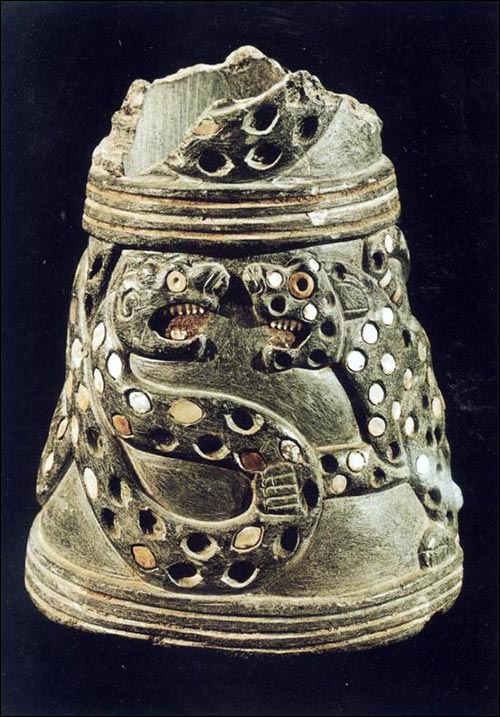Innana (?) Grappling With a Serpent [Fragment of a Ritual Vessel]--2Bd.077
Origin
The Ancient World : The Middle East : Pre-Sargonid Period
Summary
As is on the short form.
Description
The green steatite vase illustrated here was discovered by American
archaeologists at Nippur, Iraq, during the 1960-61 season of excavations.
The vase was discovered in Level VII of the temple to Inanna, and is
dated to the Early Dynastic period, roughly the first third of the third
millennium B.C. A battle between a lion or a leopard and a spotted serpent
is depicted in low relief. Mother of pearl and stone were inset into
the surface to form the eyes and the spots on the leopard, as well as
those of the serpent. Both creatures' mouths were painted red. Red and
green bands were painted along the bottom and around the band that separated
the upper and lower registers. An inscription in Sumerian on the back
reads "Inanna and the Serpent."
Cultural Context
An extraordinary architectural plan of a temple was discovered by the
American excavators to Nippur in levels they assigned the Roman numeral
VII. This level dated to the Early Dynastic II/III periods (about 2600-2400
B.C.) This sanctuary consisted of two chapels within the larger complex.
One of these was free standing in the middle of the walled in area,
and allowed access through a straight axis approach. To one side of
this shrine stood a second one, approached through the more common bent
axis entryway (where one must turn to the right or the left to face
the main cult niche after passing over the threshold entrance).
Large amounts of sculpture, cuneiform
tablets and other objects were found in association with many of the
temple's occupation surfaces, as well as buried within the walls.
The entire temple complex was dedicated
to the Sumerian goddess Inanna, the chief goddess of the temple city
of Nippur.
The steatite vase depicts the feline,
the cult animal of Inanna (as well as her Semitic counterpart, Ishtar),
struggling with a chthonic serpent that has come up out of the deep
to challenge Inanna's authority by attacking her animal. The scene no
doubt reflects a ritual process in the temple, such as combats between
deities or their representatives and their enemies, particularly serpents
from the underworld abyss. Variations of this theme occur in Mesopotamian
creation myths such as the Enuma elish.
Inanna was the goddess of love and war,
and was represented iconographically by the sun's rays extending from
her shoulders and by an eight pointed star (she was thought to be Venus).
In the Sumerian myth "Inanna's Descent to the Underworld"
Inanna descends through the seven gates of the underworld to visit her
sister Ereshkigal. After dying and lying dead for three days divine
messengers sought to find a means to restore her to life. Plants and
the "water of life" were finally obtained through the god
of the deep, Enki, and Inanna was restored. She had to find a substitute
for herself in the underworld, and this burden fell on Dumuzi.
The combat scene on the vase probably
reflects this myth, pointing to Inanna's role in the underworld, her
power over life and death, and her role in agricultural fertility.
References
Hansen, Donald P. and George F. Dales. "The Temple of Inanna, Queen
of Heaven at Nippur." Archaeology.15 (1962) pp.75-84.
|
